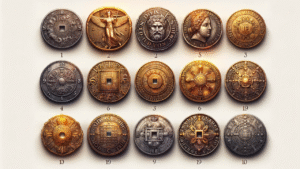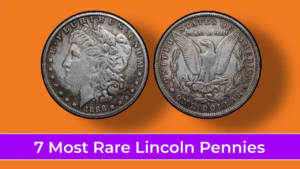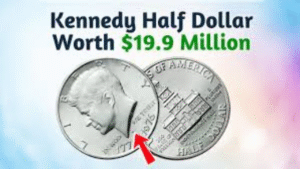Lincoln Wheat Penny Be Worth $410,000: What if a penny in your pocket was worth $410,000? The Lincoln Wheat Penny, minted from 1909 to 1958, includes rare versions that collectors pay big money for, like the 1943 copper penny or the 1909-S VDB. Some of these coins are still hiding in everyday change, coin jars, or old collections. This article explains in simple words why these pennies are so valuable, how to spot one, and what to do if you find a treasure. Start looking through your pennies today!
What Is the Lincoln Wheat Penny?
The Lincoln Wheat Penny, also called the Wheat Cent, was made by the U.S. Mint from 1909 to 1958 to honor President Abraham Lincoln. Designed by Victor David Brenner, it has Lincoln’s face on the front and two wheat stalks on the back. It was the first U.S. coin to show a real person’s portrait. Most are worth just one cent, but rare ones with errors or low production numbers can be worth thousands or even millions.
Why Are Some Pennies Worth $410,000?
Certain Wheat Pennies are valuable due to minting mistakes, rare years, or limited mint runs. For example, the 1943 copper penny, made by mistake during World War II when pennies were supposed to be steel, is a top prize. One sold for $408,000 in 1999, close to the $410,000 figure. Other rare pennies, like the 1909-S VDB, also fetch high prices due to low mintage or historical value.
The $410,000 Penny: Fact or Hype?
The $410,000 value likely refers to a 1943 copper penny or a high-grade 1909-S VDB penny sold at auction. For instance, a 1943 copper penny fetched $408,000 in 1999, and prices have climbed since, with some valued at up to $1.7 million in recent years. The exact $410,000 figure may come from a specific sale or online buzz, but it’s realistic for top-condition rare pennies. They’re still out there, waiting to be found!
Top Rare Lincoln Wheat Pennies to Hunt For
Here are the most valuable Wheat Pennies collectors are after in 2025:
1. 1943 Copper Penny
- Why Rare: Most 1943 pennies were steel to save copper for the war, but a few copper ones were made by mistake. Only about 20 exist.
- How to Spot: Check “1943” and test with a magnet—if it doesn’t stick, it’s copper.
- Value: Up to $1.7 million, with one sold for $408,000 in 1999.
2. 1909-S VDB Penny
- Why Rare: Only 484,000 were made in San Francisco with the designer’s “VDB” initials.
- How to Spot: Look for “1909-S” and “VDB” near the wheat stalks.
- Value: Up to $100,000 in top condition.
3. 1955 Doubled Die Penny
- Why Rare: A minting error doubled the text, like “LIBERTY” or the date.
- How to Spot: Check “1955” for blurry, doubled letters.
- Value: $1,000–$15,000.
4. 1914-D Penny
- Why Rare: Only 1.2 million were minted in Denver.
- How to Spot: Look for “1914” and a “D” mint mark.
- Value: Up to $159,000 in mint condition.
| Coin Type | Year | Key Feature | Estimated Value |
|---|---|---|---|
| Copper Penny | 1943 | Copper, non-magnetic | Up to $1.7 million |
| VDB Penny | 1909-S | “S” and “VDB” on back | Up to $100,000 |
| Doubled Die Penny | 1955 | Doubled text on front | $1,000–$15,000 |
| Denver Penny | 1914-D | “D” mint mark | Up to $159,000 |
How to Spot a Valuable Penny
To find a rare Wheat Penny:
- Check the Date: Look for 1909, 1914, 1943, or 1955.
- Find Mint Marks: Check for “S” (San Francisco) or “D” (Denver) below the date.
- Test 1943 Pennies: Use a magnet—copper pennies don’t stick, steel ones do.
- Look for Errors: Check for doubled text or unusual marks with a magnifying glass.
- Check Condition: Shiny, unworn coins are worth more.
Where to Find These Pennies
You might find Wheat Pennies in:
- Pocket Change: Some still circulate, especially older ones.
- Bank Rolls: Ask for penny rolls at your bank to search.
- Old Jars or Collections: Check family heirlooms or coin stashes.
- Coin Shops or Flea Markets: Look at dealers or online sites like eBay.
What to Do If You Find One
- Don’t Clean It: Cleaning can ruin its value.
- Store Safely: Put it in a plastic coin holder to avoid scratches.
- Get It Graded: Take it to PCGS or NGC for authentication and value.
- Sell Smart: Use auction houses (Heritage Auctions), dealers (APMEX), or eBay with clear photos.
Avoiding Counterfeits
Fake pennies, like 1943 steel coins coated with copper, are common. Test 1943 pennies with a magnet—real copper ones don’t stick. Check for clear details and correct weight (3.11 grams for copper). Get professional grading to confirm it’s real.
Conclusion
A Lincoln Wheat Penny worth $410,000, like the 1943 copper penny, is a real possibility, though no penny has hit that exact value recently. These coins, minted from 1909 to 1958, could be in your change, coin rolls, or old family collections. Check dates, mint marks, and test for copper, then get any finds graded by experts. The hunt for these rare pennies is thrilling, and you might uncover a small fortune. Start searching your pennies today!
FAQ
Is a $410,000 Lincoln Wheat Penny real?
Yes, a 1943 copper penny sold for $408,000 in 1999, close to $410,000. Some are worth even more today.
Which Wheat Pennies are the most valuable?
The 1943 copper penny, 1909-S VDB, 1955 doubled die, and 1914-D are the top ones.
Can I still find these pennies in circulation?
Yes, though rare, they can appear in pocket change, bank rolls, or old collections.
How do I check if my penny is valuable?
Look for 1909, 1914, 1943, or 1955, check mint marks, test 1943 coins with a magnet, and look for errors.
What should I do if I find a rare penny?
Don’t clean it, store it safely, get it graded by PCGS or NGC, and sell through auctions or dealers.



